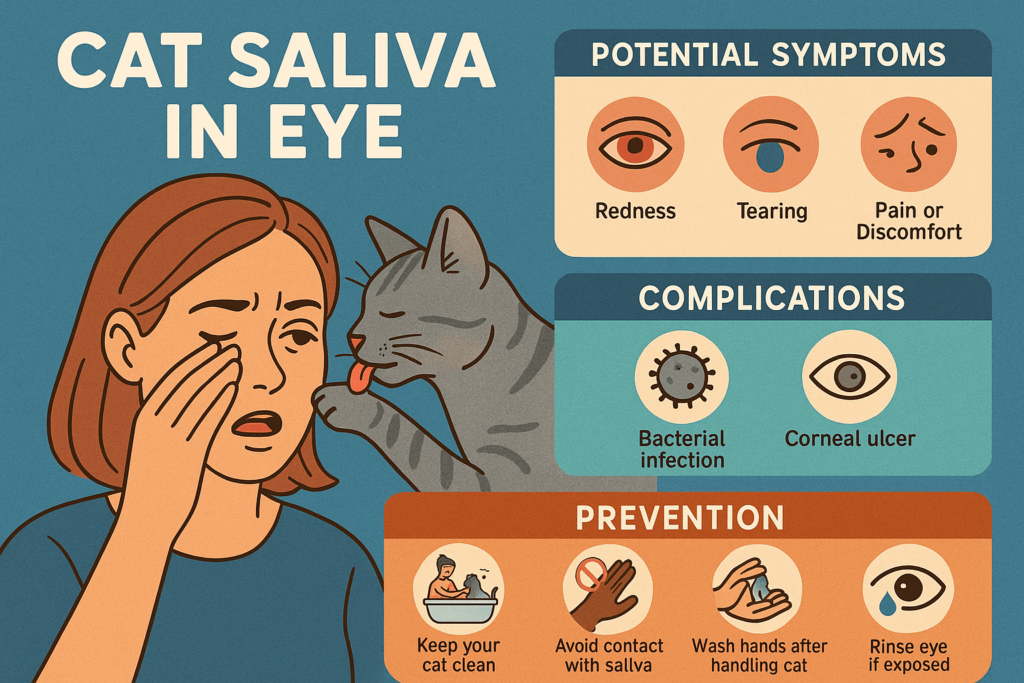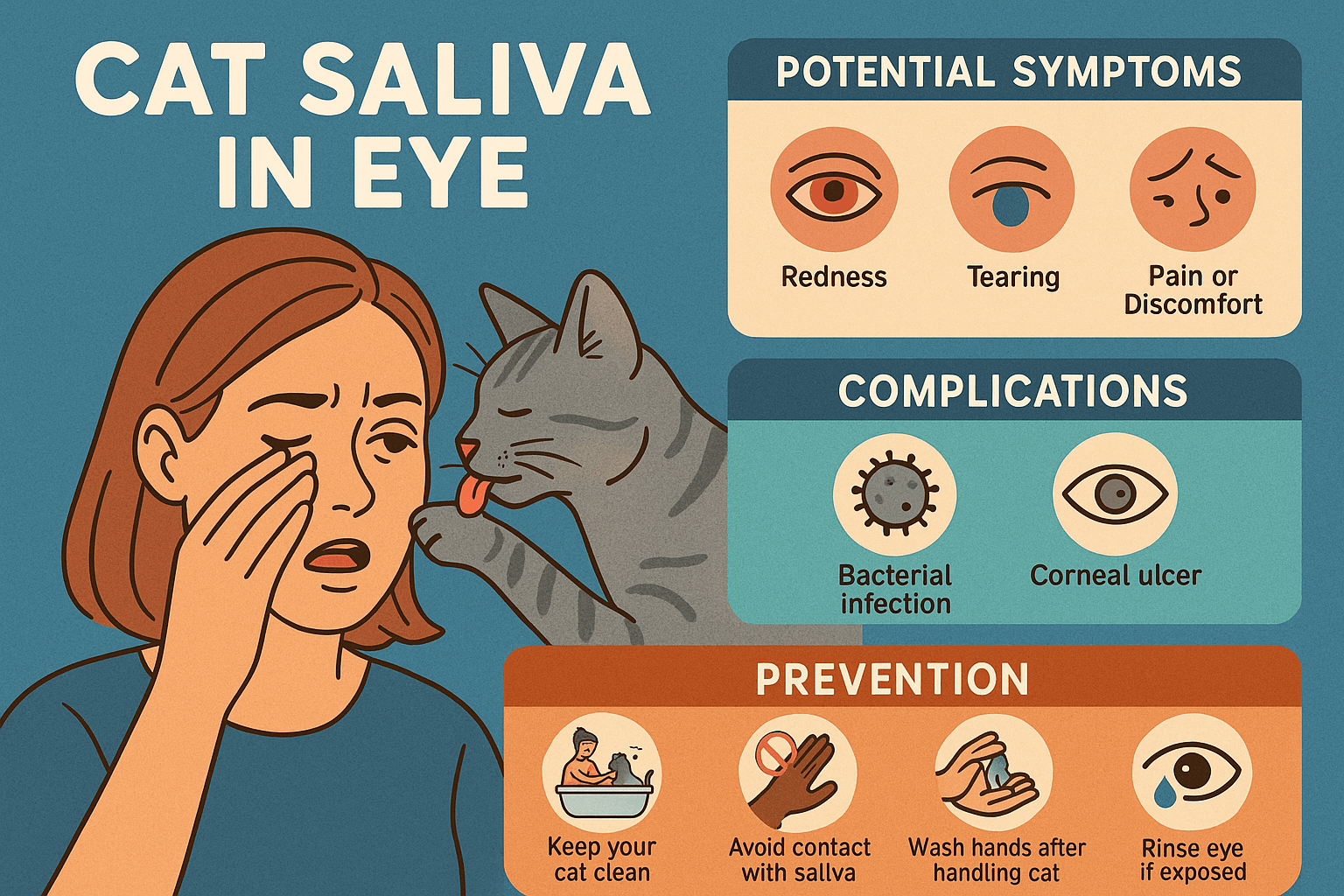Cat Saliva in Eye: What You Need to Know
Cats are known for their affectionate behaviors, including licking their owners as a sign of love and trust. However, accidental exposure to cat saliva—especially in sensitive areas like the eyes—can raise concerns about health risks. While cat saliva contains enzymes that help them clean themselves, it can also harbor bacteria or other microorganisms that may cause infections if introduced into the human body. Understanding the potential risks, symptoms to watch for, and how to respond appropriately is crucial for ensuring both your safety and your feline friend’s well-being. Let’s explore everything you need to know about dealing with cat saliva in the eye and how to prevent complications.
Potential Risks of Cat Saliva in the Eye
While not every instance of cat saliva entering the eye leads to serious issues, there are potential risks that should not be ignored. Being aware of these dangers helps you act quickly if an accident occurs.
Bacterial Infections:
Cat saliva contains bacteria such as Pasteurella multocida, which can cause infections if introduced into the eye.Irritation and Redness:
The enzymes and proteins in cat saliva may irritate the delicate tissues of the eye, leading to discomfort and redness.Allergic Reactions:
Some individuals may experience allergic reactions to cat saliva, resulting in itching, swelling, or watery eyes.Scratches from Claws During Licking:
If your cat accidentally scratches your eye while licking, it increases the risk of corneal abrasions or infections.Zoonotic Diseases:
Although rare, certain diseases like toxoplasmosis or cat scratch fever can be transmitted through saliva under specific conditions.
Understanding these risks emphasizes the importance of proper hygiene and prompt action when cat saliva comes into contact with your eye.

Immediate Steps to Take if Cat Saliva Gets in Your Eye
If your cat licks your face and their saliva enters your eye, quick action can minimize discomfort and reduce the risk of infection. Follow these steps to address the situation effectively.
Rinse Your Eye Thoroughly:
Use clean, lukewarm water or saline solution to flush out your eye immediately. Avoid using harsh chemicals or soap near the eye area.Avoid Rubbing Your Eye:
Rubbing can worsen irritation or push bacteria further into the eye. Keep your hands away unless washing them first.Check for Symptoms:
Monitor your eye for signs of redness, swelling, pain, or discharge over the next 24 hours. Persistent symptoms warrant medical attention.Wash Your Hands:
After handling your eye, wash your hands thoroughly with soap and water to prevent spreading germs.Consult a Doctor if Necessary:
If you experience severe discomfort, blurred vision, or worsening symptoms, seek professional medical advice promptly.
Taking these immediate steps ensures that any potential harm from cat saliva is addressed swiftly and effectively.
Check this guide 👉Swollen Eyes from Cat Allergies: Best 7 Expert Tips!
Check this guide 👉Understanding Cat Eye Cataracts: Best 7 Expert Tips!
Check this guide 👉Understanding Cat Eyes Anatomy: Best 7 Expert Tips!
Preventive Measures | Signs of Infection to Watch For |
|---|---|
Wash your hands after petting cats | Persistent redness and swelling |
Train your cat not to lick your face | Increased sensitivity to light |
Keep your cat’s mouth clean | Yellow or green discharge from the eye |
Trim your cat’s nails regularly | Blurred vision or difficulty seeing |
Supervise interactions with children | Severe pain or discomfort lasting days |
How to Prevent Accidental Exposure to Cat Saliva
Preventing accidents is always better than dealing with their consequences. These tips can help minimize the chances of cat saliva coming into contact with your eyes.
Discourage Face Licking:
Gently redirect your cat’s behavior by offering toys or treats whenever they attempt to lick your face.Teach Boundaries:
Train your cat to understand personal space boundaries through consistent reinforcement and positive rewards.Supervise Young Children:
Ensure young children interact safely with cats, teaching them not to provoke or allow licking near the face.Maintain Good Hygiene:
Regularly clean your hands and face after close contact with your cat to reduce the spread of bacteria.Schedule Vet Checkups:
Keep your cat healthy with routine veterinary visits, ensuring their oral hygiene is maintained to lower bacterial levels in their saliva.
By implementing these preventive measures, you can significantly reduce the likelihood of unwanted incidents involving cat saliva.
When to Seek Medical Attention
Knowing when to consult a healthcare professional is essential for addressing potential complications from cat saliva exposure. Look out for these indicators that require medical intervention.
Severe Pain or Discomfort:
Intense pain or persistent discomfort in the eye may indicate deeper damage or infection requiring treatment.Vision Changes:
Blurry vision, double vision, or difficulty focusing suggests possible injury to the cornea or surrounding structures.Prolonged Redness or Swelling:
If redness or swelling does not improve within 24-48 hours, it could signal an unresolved infection.Unusual Discharge:
Thick, yellow, or green discharge from the eye often points to bacterial involvement needing antibiotics.Fever or Systemic Symptoms:
A fever or general malaise accompanying eye symptoms may indicate a more widespread infection.
Prompt medical care ensures timely treatment and prevents long-term complications from untreated infections.
Understanding the Composition of Cat Saliva
Cat saliva has unique properties that contribute to its cleaning abilities but also pose potential risks. Learning about its composition sheds light on why caution is necessary.
Antimicrobial Enzymes:
Cat saliva contains lysozyme, which fights bacteria—but it doesn’t eliminate all harmful pathogens.High Bacterial Load:
Despite its antimicrobial properties, cat saliva hosts numerous bacteria that can harm humans.Proteins That Aid Grooming:
Proteins in saliva help break down food particles, aiding self-cleaning but potentially irritating human skin or eyes.pH Levels Differ from Human Saliva:
The slightly alkaline nature of cat saliva can disrupt the balance of human tissues upon contact.Presence of Toxoplasma gondii (Rare):
Though uncommon, toxoplasmosis parasites might be present in saliva, posing risks to pregnant women or immunocompromised individuals.
Awareness of these components underscores the importance of careful handling and hygiene around cats.
Signs Your Cat May Be More Likely to Lick Unwanted Areas
Some cats are more prone to licking faces or other sensitive areas due to behavioral traits or environmental factors. Identifying these tendencies helps prevent accidents.
Affectionate Breeds:
Certain breeds, like Ragdolls or Maine Coons, are naturally more inclined to show affection through licking.Bonding Behavior:
Cats often mimic grooming habits seen among littermates, viewing licking as a form of social bonding.Anxiety or Stress:
Cats experiencing anxiety may express comfort-seeking behaviors, including excessive licking.Curiosity Toward Faces:
Facial movements and scents attract curious cats, prompting them to investigate closely.Lack of Training Boundaries:
Without guidance, cats may not recognize inappropriate areas for licking.
Addressing these behaviors early reduces the chance of unwanted licking incidents.
Home Remedies vs. Professional Treatment for Eye Irritation
While mild cases of eye irritation from cat saliva can often be managed at home, knowing when to escalate to professional care is critical. Compare these options to make informed decisions.
Warm Compresses:
Applying a warm compress can soothe minor irritation caused by cat saliva exposure.Over-the-Counter Eye Drops:
Artificial tears or saline solutions help rinse and hydrate the eye temporarily.Monitoring Progress:
Track improvements over 24-48 hours; lack of improvement indicates the need for medical evaluation.Prescription Medications:
Doctors may prescribe antibiotic drops or ointments for confirmed infections.Follow-Up Care:
Attend follow-up appointments to ensure full recovery and rule out lingering issues.
Balancing home remedies with professional guidance ensures optimal outcomes for eye health.
Frequently Asked Questions About Cat Saliva in the Eye
Is cat saliva harmful to humans?
While most people won’t experience serious effects, cat saliva can carry bacteria that may cause infections in certain circumstances.
What should I do if my cat licks my eye?
Rinse your eye immediately with clean water or saline solution and monitor for symptoms. Seek medical help if needed.
Can I get rabies from cat saliva in my eye?
Rabies transmission via saliva in the eye is extremely rare but possible if the cat is infected. Vaccinate your pets against rabies to stay safe.
How can I stop my cat from licking my face?
Redirect their behavior with toys or treats, and establish clear boundaries during interactions.
Are some people more at risk than others?
Individuals with weakened immune systems, allergies, or pre-existing eye conditions may face higher risks from cat saliva exposure.
Staying Safe While Enjoying Feline Companionship
Accidents involving cat saliva in the eye are rare but worth taking seriously due to potential health risks. By understanding the dangers, practicing good hygiene, and seeking medical attention when necessary, you can protect yourself without compromising the bond you share with your furry companion. Remember, prevention is key—training your cat, maintaining cleanliness, and supervising interactions go a long way toward avoiding mishaps. With awareness and care, you can enjoy a harmonious relationship with your cat while staying safe and healthy.
Understanding Cryptosporidium in Cats: Best 7 Expert Tips! – Spot symptoms, treat safely, and stop parasite spread in your home.
Understanding Cryptosporidium in Dogs: Best 7 Expert Tips! – Learn symptoms, treatment & prevention for this stubborn gut parasite.
Understanding Syringomyelia in Cats: Best 7 Expert Tips! – Recognize signs, manage pain, and support your cat’s neurological health with vet-backed guidance.
Understanding Syringomyelia in Dogs: Best 7 Expert Tips! – Expert insights on symptoms, MRI diagnosis, pain management & quality of life.





